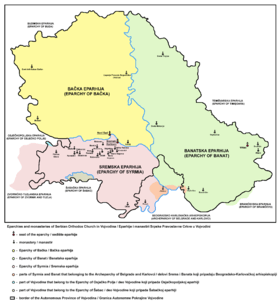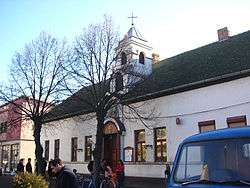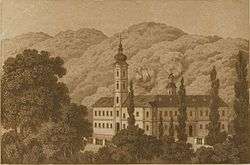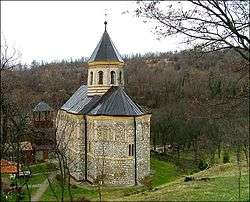Eparchy of Srem
| Eparchy of Srem Епархија сремска | |
|---|---|
|
| |
| Location | |
| Territory |
Syrmia in Serbia plus three parishes in Croatia |
| Headquarters | Sremski Karlovci, Sremski Karlovci |
| Information | |
| Denomination | Eastern Orthodox |
| Sui iuris church | Serbian Orthodox Church |
| Language |
Church Slavonic Serbian |
| Current leadership | |
| Bishop | Episcop Vasilije |
| Map | |
-en.svg.png) | |

.png)
The Eparchy of Srem (Serbian: Сремска епархија or Sremska eparhija) is an ecclesiastical territory or eparchy of the Serbian Orthodox Church in the Syrmia (Srem) region, Serbia. It is mostly situated in the autonomous province of Vojvodina, while the eparchy also include a small south-eastern part of Syrmia that belong to Belgrade as well as some Syrmian settlements that are part of Croatia. The seat of the eparchy is in Sremski Karlovci.
History
Eparchy of Srem is one of the oldest ecclesiastical institutions in this part of Europe. Ancient Bishopric of Sirmium was an important ecclesiastical center of the late Roman Empire during 4th and 5th century. Bishopric collapsed after 582 when ancient Sirmium was finally destroyed by Avars.
After the Christianization of Slavs, eparchy was renewed and since 1018 it belonged to the Eastern Orthodox Archbishopric of Ohrid. During the late Middle Ages, the region of Srem came under jurisdiction of Serbian Metropolitans of Belgrade. The most notable was Saint Maksim Branković, metropolitan of Belgrade and Srem (died 1516). During 16th and 17th centuries they styled themselves as Metropolitans of Belgrade and Srem. In 1708, when autonomous Serbian Metropolitanate in Habsburg Monarchy was created, Eparchy of Srem became archdiocese of the Metropolitan, whose seat was in Sremski Karlovci. Eparchy remained part of Metropolitanate of Karlovci until the end of the First World War.
In 1920, after all Serbian ecclesiastical provinces united into one Serbian Orthodox Church, Eparchy of Srem with its seat in Sremski Karlovci came under administration of Archbishop of Belgrade who was also the Serbian Patriarch. Final unification of two eparchies was completed in 1931 when Eparchy of Srem was joined with the Archbishopric of Belgrade into the Archbishopric of Belgrade and Karlovci.
In 1947, region of Srem was excluded from the Archbishopric of Belgrade and Karlovci and reestablished as separate Eparchy of Srem. Although, the name of the Archbishopric of Belgrade and Karlovci still includes the name of the town of Sremski Karlovci, this town is today part of the Eparchy of Srem and not of the Archbishopric of Belgrade and Karlovci.
Monasteries belonging to the eparchy
- Beočin - The time of founding is unknown. It is first mentioned in Turkish records dated in 1566/1567.
- Bešenovo - According to the legend, the monastery of Bešenovo was founded by Serbian king Dragutin at the end of the 13th century. The earliest historical records about the Monastery are dated in 1545.
- Velika Remeta - Traditionally, its founding is linked to the king Dragutin. The earliest historical records about the Monastery are dated in 1562.
- Vrdnik-Ravanica - The exact time of its founding is unknown. The records indicate that the church was built during the time of Metropolitan Serafim, in the second half of the 16th century.
- Grgeteg - According to tradition the monastery was founded by Zmaj Ognjeni Vuk (despot Vuk Grgurević), in 1471. The earliest historical records about the Monastery are dated in 1545/1546.
- Divša - It is believed to have been founded by despot Jovan Branković in the late 15th century. The earliest historical records about the Monastery are dated in the second half of the 16th century.
- Jazak - The monastery was founded in 1736.
- Krušedol - The monastery was founded between 1509 and 1516, by Saint Maksim Branković), Metropolitan of Belgrade and Srem, and his mother Saint Angelina of Serbia.
- Kuveždin - Traditionally, its foundation is ascribed to Stefan Štiljanović. The first reliable records of it are dated in 1566/1569.
- Mala Remeta - The foundation is traditionally ascribed to the Serbian king Dragutin. The earliest historical records about the Monastery are dated in the middle of the 16th century.
- Novo Hopovo - According to tradition, the monastery was built by the Despots of the Branković family. The first reliable mention of monastery is dated in 1641.
- Privina Glava - According to the legends, Privina Glava was founded by a man named Priva, in the 12th century. The earliest historical records about the Monastery are dated in 1566/1567.
- Petkovica - According to the tradition, founded by the widow of Stefan Štiljanović, despotess Jelena. The earliest historical records about the Monastery are dated in 1566/1567.
- Rakovac - According to a legend written in 1704, Rakovac is the heritage of a certain man, Raka, courtier of despot Jovan Branković. The legend states that Raka erected the monastery in 1498. The earliest historical records about the Monastery are dated in 1545/1546.
- Staro Hopovo - According to the tradition, the monastery was founded by Metropolitan Maksim Branković. The reliable data about the monastery date back to 1545/1546.
- Šišatovac - The foundation of the Monastery is ascribed to the refugee monks from the Serbian Monastery of Žiča. The reliable facts illustrating the life of the monastery date back from the mid 16th century.
- Fenek - According to tradition, the founders of Monastery were Stefan and Angelina Branković, in the second half of the 15th century. The earliest historical records about the Monastery are dated in 1563.
Galery
Monasteries of Fruška Gora
Churches
-

Sremski Karlovci Cathedral
-
Church in Sremska Mitrovica
-

The temporary Orthodox church in Nova Pazova
-

Church in Ruma
-

Church in Inđija
-

Church in Šid
-
Church in Voganj
Seminary
The eparchy also possess an Orthodox seminary in Sremski Karlovci. The seminary was founded in 1794. It was the second oldest Orthodox seminary in the World (After the Spiritual Academy in Kyiv), and it operates to this day.
See also
- Serbian Orthodox Church
- List of the Eparchies of the Serbian Orthodox Church
- Religion in Serbia
- Religion in Vojvodina
Bibliography
- Вуковић, Сава (1996). Српски јерарси од деветог до двадесетог века (Serbian Hierarchs from the 9th to the 20th Century). Евро, Унирекс, Каленић.
External links
Coordinates: 45°12′5″N 19°56′11″E / 45.20139°N 19.93639°E







